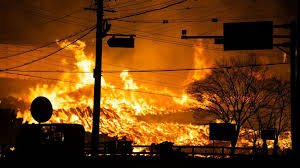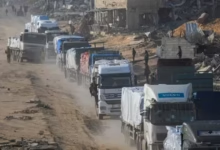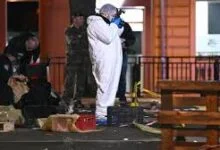South Korea: Death toll in ‘worst ever’ wildfires rises to 24

At least 24 people have been killed as multiple wildfires continue to ravage South Korea’s south-east region.
Most of the victims are in their 60s and 70s, authorities say, adding that some 26 people are injured – with 12 in critical condition. More than 23,000 people have been forced to flee their homes.
The “unprecedented” crisis is “rewriting the record books for the worst wildfires in our nation’s history”, acting president Han Duck-soo has said.
The fires gutted a 1,300-year-old temple in Uiseong city, where many cultural relics were removed and transported to safer ground.
The fires started in Sancheong county on Friday and later spread to Uiseong county.
Fuelled by strong and dry winds, they spread to the neighbouring counties of Gyeongbuk, Uiseong, Andong, Cheongsong, Yeongyang and Sancheong.
On Tuesday, the national fire agency raised the crisis to the highest fire response level.
On Wednesday, a firefighting helicopter crashed in the mountains of Uiseong, killing the pilot. Officials are investigating the cause.
Thousands of firefighters and about 5,000 military personnel have been deployed to contain the flames, as well as helicopters from the US military stationed in Korea.
Wildfires are relatively uncommon in South Korea. The current fires are already the deadliest in its history.
About 17,000 hectares (42,000 acres) of forest have also been destroyed, making the fires the third largest in South Korea’s history in terms of area.
More than 23,000 people have been evacuated
One resident of a village in Andong told BBC Korean: “Our house has completely burned down. It was almost completely collapsed.”
Elsewhere in Andong, people sheltering at an elementary school were told to leave quickly as the fire was spread by gusty winds.
A 30-year-old man living in Uiseong said: “Both the upstairs and next door houses were burned down. This area is full of grandparents. They have lived here their whole lives, and when their houses burn down, they have nowhere to go.”
In the city of Uiseong, the fire destroyed the Gounsa temple – one of the largest temples in the province built in 618 AD.
A 68-year-old monk said he was “devastated” when he heard that about the destruction of the Gounsa temple. “We will do our best to restore the function of the temple,” he told AFP news agency.
A Buddhist architectural structure deemed a national treasure from the Joseon Dynasty (1392-1910) was also destroyed, forestry authorities confirmed.
In Andong, truck driver Lee Seung-joo said he saw the mountains burn as he drove by. “It was like the apocalypse,” the 39-year-old said, according to AFP.
Acting president Han said strong winds were still hampering firefighting and rescue efforts.
“We were desperately hoping for rain today or tomorrow to help extinguish the flames,” Han added.
No rain was forecast for the region on Wednesday and only a small amount – five to 10mm – expected on Thursday, according to the Korea Meteorological Administration.
South Korea has been experiencing drier than normal conditions with less rainfall than average. There have already been 244 wildfires this year – 2.4 times more than the same period last year.
The government also promised to strengthen enforcement against illegal burning -one of the main causes of wildfires – and crack down on individual carelessness.
—BBC







